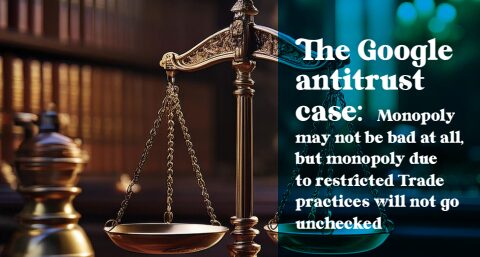The Google antitrust case: Monopoly may not be bad at all, but monopoly due to restricted Trade practices will not go unchecked

The balance between innovation and competition has remained intricate in the tech space. On the one hand, the argument has been that the law should not be enacted to stifle innovation, while on the other, innovation itself has somehow managed to create new schemes of circumventing regulatory constraints.
This ensuing situation has not only attracted the attention of regulatory agencies but also courts, which are wading into these murky waters. The perfect example is the recent ground-breaking decision by a US court on Google’s alleged monopolistic tendencies. For corporates, this decision deserves detailed attention, as it portends a potential landmark shift in competition and consumer protection concerns.
In Detail: Unpacking the Ruling
Central to the Google antitrust case is the court’s definition of monopolistic tendencies and the specific practices deemed anti-competitive. Highlights of the decision are as follows:
- The court found that Google possessed monopoly power in the general search and search advertising markets. This determination was based on factors such as Google’s market share, the absence of close substitutes, and the company’s ability to control prices and exclude competitors.
However, as is always the case, mere dominance is not enough to establish antitrust liability. Where a court is seized of such a matter, it must go far and beyond and establish the existence of anti-competitive conduct.
- Also, particularly in this case, the court focused on Google’s exclusive distribution agreements with device manufacturers and browser makers. These agreements made Google Search the default search engine, significantly hindering competitors’ ability to gain traction.
The court characterised these agreements as anti-competitive because they excluded rivals, foreclosed competition, and reduced consumer choice. By tying up distribution channels, Google effectively erected barriers to entry for other search engines, reinforcing its monopoly position.
- The court also found that Google’s ad practices contributed to its monopolistic behaviour. The company’s control over the ad auction process and its ability to favour its ad products allowed it to charge higher prices to advertisers. This reduced competition in the ad market and harmed consumers.
Implications of the Court’s Decision
In essence, the court’s ruling emphasises that monopoly power, coupled with anti-competitive conduct that harms competition and consumers, is sufficient to establish antitrust liability. This definition provides a clear framework for future antitrust cases involving dominant firms.
In the decision, the court underscored that Google wielded monopoly power in “general search services” and “general search text ads” and concluded that the company had engaged in anti-competitive practices to maintain this dominant position. Specifically, the court highlighted Google’s exclusive and anti-competitive distribution agreements, which favoured Google Search as a default and artificially inflated prices for Google Ads. These practices, the court argued, stifled competition and innovation.
This ruling brings to fore the following:
- Increased Scrutiny, Proactive Approach
From the very onset, this decision demonstrates a growing willingness of courts to hold companies – regardless of standing – accountable for anti-competitive behaviour and restricted trade practices. While this heightened scrutiny is driven by concerns over market concentration, consumer harm, and the stifling of innovation, it also presents an opportunity for entities to reconsider and recalibrate their practices, now more than ever.
Courts are increasingly intolerant of monopolistic tendencies, and therefore, entities must be vigilant in their business practices to avoid violating antitrust laws. This requires a proactive approach to competition compliance, including regular antitrust risk assessments, robust internal controls, and staying abreast of evolving legal and regulatory landscapes.
- Spotlight on the Digital Economy
The ruling sets a new precedent for defining monopoly power and identifying anti-competitive conduct. Predictably, competition authorities will now begin to adopt a more aggressive stance towards firms they deem or consider dominant, leading to increased enforcement actions and stricter regulations.
Moreover, this decision raises questions about the role of government in regulating competition concerns aimed at ensuring fair competition and protecting consumers.
Conclusion
Ultimately, the Google antitrust case is a complex and evolving legal battle with far-reaching consequences. While the full impact of the ruling remains to be seen, it undoubtedly marks a watershed moment in antitrust enforcement and a call to action for corporates. This means corporates need to analyse their operations and ensure their operations, at the very least, do not mirror anti-competitive conduct. Remember, the question of dominance can be argued, but dominance due to uncompetitive conduct will not go unchecked.

